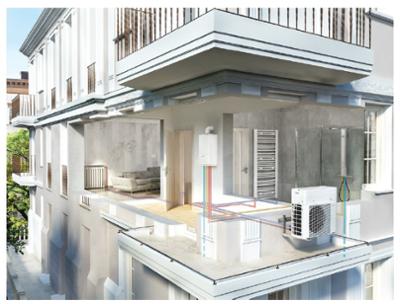

Hybrid systems, a solution to multi-family building refurbishment

Following the adoption of the Energy Performance of Buildings Directive (EPBD), which focuses on the decarbonisation of the building sector (heating and cooling), doubling the renovation rate of existing buildings and increasing the replacement of the boilers are the main aims. Asier Dobaran and Gaspar Martín, members of the Technical Commission of FEGECA (Manufacturers of Heat Generators and Emitters), explain the best solution for the refurbishment of multi-family buildings.
The Energy Performance of Buildings Directive will require all new buildings to be zero-emission by 2030 and existing buildings to be zero-emission by 2050. While the target for existing buildings sounds far off today, the EPBD has set some additional challenges to be met before that date. The directive puts the focus on the energy performance of existing, less efficient buildings and aims for Member States to define maximum energy consumption standards (kWh/m2 a), obliging these existing buildings to save energy (and CO2 emissions). Specifically, it "sets a target that 55% of savings should come from buildings in the lowest energy categories (G and F) and encourages Member States to design plans for the renovation of the existing building stock".
The EPBD proposes different ways to save energy and decarbonise the existing stock: "Improvements to the building envelope, use of solar thermal and photovoltaic energy, use of renewable fuels, electrification of air conditioning systems through the use of heat pumps, and use of hybrid systems".
In particular, for high-rise buildings, all of the above-mentioned methods present significant challenges for implementation, according to Asier Dobaran and Gaspar Martín. "But perhaps the option of electrifying heating and air-conditioning systems is the most difficult route to take. If we look at the stock of buildings already constructed, approximately 70% of the housing stock in Spain is made up of high-rise buildings (approximately 18 million dwellings). 54% of the dwellings were built before 1980, so their energy demand is quite high. In addition, approximately 2 million households have a centralised heating system and more than 8 million have an individual heating system".
Replacement of generators
The possibility of replacing existing generators with heat pumps in these centralised facilities "is limited by the access options to the outside due to the lack of sufficiently large usable flat roofs, or by the ability to accommodate storage and/or inertia systems of sufficient volume" (required when transitioning to electric systems to meet a thermal demand).
Although in many of these centralised facilities it is difficult to replace the full output of existing gas boilers with electric systems, "it is often feasible to combine the use of boilers with heat pumps that cover a fraction of the total annual thermal energy demand, working in a hybrid configuration".
Likewise, for high-rise buildings with an individual generator, the size of the building and the availability of balconies does not allow the installation of heat pumps of the power required to meet the total demand on their own. "In cities, more than 70% of dwellings have a floor area of less than 90m2 , and in the largest population centres, dwellings with a floor area of less than 60m2 represent 25%.
In homes of this type, it is difficult to install storage tanks and buffer tanks, so "the production of instant domestic hot water with a gas generator supported by a heat pump that covers the base heating demand can facilitate the decarbonisation of this type of home". In this case, it would also be working with the philosophy of a hybrid system. "We therefore see that such hybrid systems can be a good solution to decarbonise our existing buildings where full electrification is not feasible.




